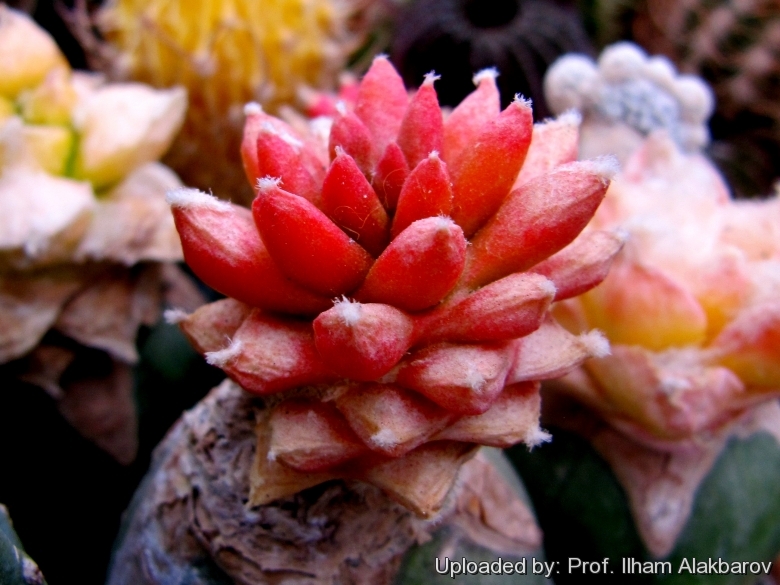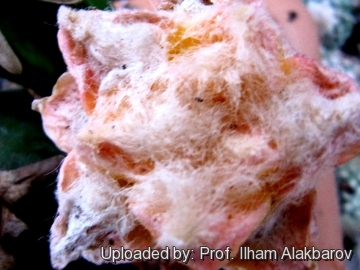
Ariocarpus hybrid f. rubra Photo by: Prof. Ilham Alakbarov
Origin and Habitat: Garden origin (Nursery produced cultivar)
Synonyms:
Description: Some of the most intriguing Ariocarpus cultivars are the result of multi-hybrid programs and possess unique and attractive characteristics. Particularly the Ariocarpus retususSN|26149]]SN|2079]] has been extensively hybridized whit other species of the genus. That is why hybrid seeds are easy to obtain as most of the species are easy to cross, and their seeds have a high germination capacity that lasts for 2 or more years. Many generations of hybrids were realized, creating interesting forms and cultivars. Multi hybrids generally display an exclusive combination of distinctive traits derived from a line of complex breeding which incorporates many different species and or hybrids. So rather than taking after one parent or another, they can resembles many of the plants in which they was bred from. Seedlings of Ariocarpus hybrids show frequently non-typical colouring developing variegated or chlorophyll-less (red or yellow) stems, or developing crested, monstrous or other abnormal forms that yet have to be named.
Forma rubra (red form): The red schizochromic form (Ariocarpus hybrid f. rubraSN|2079]]SN|26149]]) has bright orange-red stems due to the absence (or reduced production) of chlorophyll pigments: every other pigment is present at normal levels, the dominant green colouration is lost, but will still more than likely have normal other pigments that give the yellow overall appearance of the stem. This form with red stems is very attractive and highly prized. This schizochromic form is almost always seen grafted on stronger columnar species, and cannot can be grown on its own roots. However some clones have enough chlorophyll in their tissues and can be grown on they own roots too, but very slow growing.
 Ariocarpus hybrid f. rubra Photo by: Prof. Ilham Alakbarov
Ariocarpus hybrid f. rubra Photo by: Prof. Ilham AlakbarovSend a photo of this plant.The gallery now contains thousands of pictures, however it is possible to do even more. We are, of course, seeking photos of species not yet shown in the gallery but not only that, we are also looking for better pictures than those already present.
Read More... Cultivation and Propagation: Variegated and albinos cacti are regarded as choice and difficult in cultivation, but despite that many of them are relatively easy to grow. But be aware that they cannot tolerate prolonged exposure to direct sun light (especially during the hottest summer days), so grow them in half-shade or under filtered sun. They are sometime seen as grafted plants, but many grow well on their own roots, too.
On the contrary, the albinos can survive only if grafted on a strong green base.
Use mineral well-permeable substratum with little organic matter (peat, humus). Water sparingly from March till October and keep perfectly dry in winter at temperatures from 5 to 15 degrees centigrade. (In general these plants are more tender and cannot endure freezing temperatures ) In the rest period no high atmospheric humidity!!
Propagation: Usually by seed. Plants are often grafted onto column-shaped cacti.











